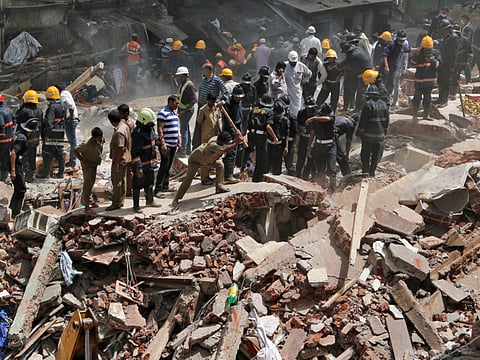Mumbai building collapse kills 12 after heavy rains
More than a dozen others were pulled from the rubble of the four-storey residential building

MUMBAI: At least 12 people died Thursday when a building collapsed in India’s financial capital Mumbai following heavy rains that have wreaked havoc in many parts of South Asia.
More than a dozen others were pulled from the rubble of the four-storey residential building, which gave way around 08:40am (0310 GMT) in the densely populated Bhendi Bazaar area.
It was the most recent deadly housing collapse to strike the teeming metropolis — throwing the spotlight on poor construction standards in the Asian country — and came after flooding in the city killed 10 people.
“Twelve people have died including three women and nine men. Rescue operations are ongoing,” Vijay Khabale-Patil, a spokesman for Mumbai’s civic authority, told AFP.
Ambulances rushed more than a dozen injured to the nearby J.J. Hospital in the south of the city while locals joined a 43-member NDRF team in picking through piles of debris in a desperate hunt for survivors.
“I can confirm that 11 people are dead and 15 have been brought here injured, including three who are in a critical condition,” the dean of the hospital, T.P. Lahane, told AFP.
Building collapses are common in Mumbai, especially during the monsoon season from late June to September, when heavy rains lash the western Indian city, weakening poorly built structures.
Severe downpours caused flooding and chaos across Mumbai and the neighbouring region of Thane on Tuesday although waters had receded by late Wednesday.
Bhendi Bazaar, a scruffy colonial-era market, is one of Mumbai’s most historic districts and officials said the collapsed building was 117 years old.
It had been marked for demolition as part of a $600 million (Dh2.20 billion) redevelopment project that is currently replacing hundreds of ramshackle, decades-old low-rise buildings with around a dozen glitzy new tower blocks.
Distraught residents said they rushed to the scene of the collapsed structure after hearing a loud crash.
“There was a huge noise and we all came running,” Naseem Mogradia, who lives two lanes away, told AFP.
Shahid Khan, 52, said he didn’t know whether his friend and seven family members who lived on the ground floor were alive or dead.
“I am just trying to help with rescue operations,” he told AFP.
Mumbai has been hit by several deadly building collapses in recent years, often caused by shoddy construction, poor quality materials or ageing buildings.
Millions are forced to live in cramped, ramshackle properties because of spiralling real estate prices and a lack of housing for the poor.
Activists say housing societies, private owners and builders often cut corners to save on costs.
Rent control acts mean landlords cannot afford to maintain buildings while poor people choose to remain in homes even after they have been declared unsafe because they have nowhere else to go.
“Most of the buildings in Bhendi Bazaar are old and dilapidated. We always live in fear that they will collapse during monsoons,” 63-year-old Mohammad Shaikh told AFP.
In July, 17 people including a three-month-old baby died when a four-storey building gave way in the northern suburb of Ghatkopar.
In 2013, 60 people were killed when a residential block came crashing down in one of Mumbai’s worst housing disasters.
On Thursday officials in Mumbai said the death toll from floods in and around the city were expected to rise above 10 as the waters receded.
“We are still on the lookout for more missing persons and the number may go up,” Santosh Kadam, spokesman for disaster control in Thane, told AFP.
More than 1,200 have been killed in India, Nepal and Bangladesh in devastating floods this monsoon season.
— AFP
Sign up for the Daily Briefing
Get the latest news and updates straight to your inbox


